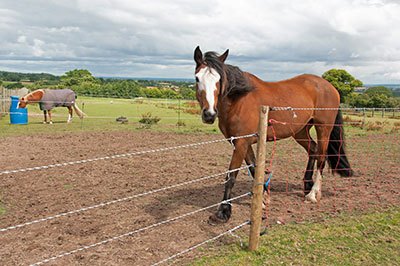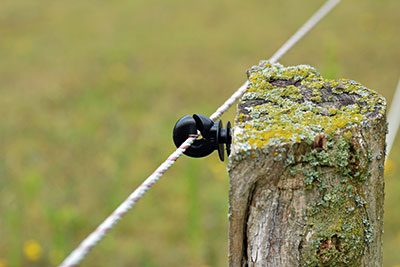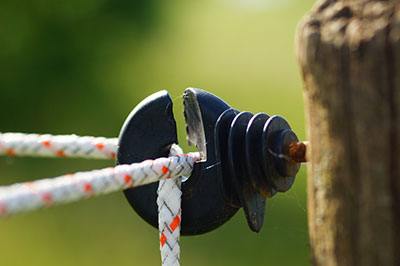Are you having a hard time corralling your horses? Trying to find an effective and durable solution that can protect your animals from straying too far away, but not injuring them in the process?
A braided electric fence wire could be your best bet. Not only is it highly flexible and relatively inexpensive, but it’s also proven to provide effective containment for horse pastures.
In this guide, we’ll discuss why braided electric fence wire may be the perfect choice for your animal’s needs. So let’s get started!
Take away key points:
- Braided fences are ideal for horses and other cattle
- They contain different glass filled-nylon parts, ad copper, as the only copper wiring offers the oxidized protective coating, called patina to ensure rust-resistance
- Thanks to their durability and design, fences make electric shock harmless to people and animals and are ideal for more robust use
Braided electric fence rail systems for your horses: Yes or no?
If you want to learn about the advanced and safe horse fence and learn how to best protect your animals in the field, read our guide below.
We will answer all your questions regarding the braided horse fencing systems.
What is a braided fence?

A braided electric fencing wire is a type of fencing system designed to provide a safe and secure barrier for horses. It consists of polyester fibers with 16 stainless steel conductors woven through them, creating an electrified rope-like material.
This type of fencing is both a physical barrier and an electrical barrier, making it ideal for keeping horses contained in an area without putting them in danger. The electric fencing wires are available in 1320′ rolls, as well as other lengths depending on the manufacturer.
Additionally, some brands offer specialized features such as no-kick gate handles, brass, and copper components, copper wires, or poly wire tighteners to further ensure the safety of the animals.
Braided electric fence wires are easy to install and maintain, making them popular among horse owners looking for an effective yet affordable solution for containing their animals. So, they are more advanced than cheap high-tensile wire solutions.
They are also highly visible due to their bright colors, allowing riders to easily spot any potential hazards while riding near the fence line, offering better conditions than a conventional high-tensile wire. With proper care and maintenance, these fences can last for many years and provide reliable protection for your horses.
Overall, braided electric fence wires are an excellent choice for horse owners looking for a safe and secure way to contain their animals without breaking the bank. They are easy to install and maintain, highly visible, and provide reliable protection from potential hazards.
Braided fence wire types
Braided fence wire is a type of fencing that consists of multiple strands of metal or plastic woven together to form a strong, durable barrier. It is often used for agricultural purposes, as it can be used to contain animals and protect crops from predators. There are several different types of braided fence wire available, including:
– galvanized steel,
– aluminum,
– polyethylene, and
– polypropylene.
Each type has its advantages and disadvantages depending on the specific application.
Galvanized steel is the most common type of braided fence wire and is made by coating steel with zinc to prevent rusting and corrosion. It is strong and durable, making it an ideal choice for areas with harsh weather conditions or heavy use.
Horses often don’t see the steel fence wires but in combination with the protective coating the copper wires offer, these are better solutions for your horse’s needs.
Aluminum braided fence wire is also very popular due to its lightweight nature and resistance to corrosion.
Polyethylene and polypropylene are both synthetic materials that are more flexible than metal but still provide good strength and durability.
No matter which type of braided fence wire you choose, it’s important to make sure that it meets your needs in terms of size, strength, flexibility, and cost. Additionally, you should always check with local building codes before installing any kind of fencing to ensure compliance with regulations.
How to properly install braided fences?
Installing braided fences is relatively straightforward, but it’s important to take the time to plan and prepare properly. Here are some tips for installing braided fence systems.
– Start by planning out the layout of your fence. Consider factors such as terrain, the size of your property, and the type of animals you have. This will help you determine how many posts and strands of fencing you need.
– Gather all the necessary materials for installation, including posts, wire, clips, insulators, and other tools like post drivers or augers. The good news is that there are no sharp edges, sharp points, or other barriers to hurting your high-strung animals and herd animals.
– Install corner posts first using either post drivers or augers depending on soil conditions. Make sure they are firmly in place before moving on to the next step. Conventional horse fences require fence posts every 8 to 10 feet. But, with the electric fence braid wire, you can place horse fencing posts every 30 to 50 feet apart.
– Attach wire to corner posts using clips or insulators depending on what type of wire you are using (e.g., electric). Make sure there is enough tension in the wire so that it won’t sag over time.
– Securely attach additional fence posts along the length of your fence line with post drivers or augers as needed for support and stability.
– Finally, attach additional strands of wire between each post using clips or insulators as needed for extra security and strength in your fence system.
If you cannot manage, contact your professional fence installer to help you.
Can you braid your existing horse fence?

Yes, you can braid your existing horse fence with different braiding products available on the market. You can use woven electrical horse tape, copper wire conductors, a CSA-approved fence energizer, an ElectroBraid fence charger, and other low-maintenance cost units to ensure the proper functions of the braided horse fencing.
These products are designed to provide a physical barrier and psychological deterrent for horses while also being easy to install. Additionally, some of these products come with warranties of up to 25 years.
Is a braided fence better than a pipe and cable fence for horses?
The answer depends on the specific needs of the horse owner. Pipe and cable fences can be very strong and durable, making them a good choice if you need a fence that will last for many years. However, they can also be quite hard and unforgiving if a horse were to run into them.
Braided fences, on the other hand, offer more flexibility and cushioning if a horse were to hit them. This makes them safer for horses than pipe or cable fences in some cases.
In addition to safety considerations, the maintenance cost-low demands are also important factors when choosing between pipe and cable vs braided fences. Generally speaking, braided fences tend to be more expensive than pipe or cable ones due to the extra materials needed for weaving the wires together.
Pros and cons of braided electric fences
There are different advantages and disadvantages the braided fencing systems offer:
Pros
– Mildew-resistant and highly visible to horses, making them a great option for keeping your horse safe and secure.
– Much cheaper unlike cattle wire fencing and installed cost low
– Provides a strong psychological barrier that can keep horses from wandering off or getting injured
– Easy to install fence correctly and maintain, requiring minimal effort on the part of the owner.
– The electric shock will not hurt horses and their babies; it absorbs the energy of the panicked horse and bounce them back into the pasture
Cons
– It can be difficult to repair if it becomes damaged or broken due to wear and tear over time.
– Not as strong as traditional wire fencing in certain areas where predators may be present.
– Not suitable for all types of terrain; they can become stretched out or tangled in rough terrain or areas with high winds.
Maintenance tips for braided electric fences
Here are some tips to help you maintain your braided electric fence:
– Check the voltage levels of the psychological deterrent regularly. This will help you identify any issues with the power supply and make sure that the insulator construction is working correctly.
– Make sure that all of the posts, insulators, and parallel electrical conductors are securely fastened in place. This will help prevent any damage or wear and tear on the fence over time, ensuring the line posts are working continually.
– Mow weeds, tree falls, and grass away from the bottom strand of the fence to prevent them from touching it. If such an accident happens, instantly clean the area to ensure the proper working conditions.
– Check for any signs of corrosion or rust on the wires and posts, as this can weaken their strength over time. Copper wire doesn’t rust, and it’s the best natural conductor of electricity. Copper develops an oxidized outer layer to protect wires from natural electrolytic corrosion. Still, check them often to ensure the best use.
– Inspect all connections between wires and posts to make sure they are secure.
– Make sure that there is adequate tension on all strands of wire so that they don’t sag or become loose over time.
– Replace any broken or damaged parts as soon as possible to avoid further damage to your fence.

FAQs
How long does ElectroBraid last?
The ElectroBraid fence lasts up to 25 years.
Are braided electrical cords safe?
Yes, the braided horse fencing cords are safe for users and all the horses in the enclosed area.
Is braided wire better than solid?
No, it’s vice versa, solid wires are better conductors than braided wires.
Will braided line damage my rod?
No, they won’t damage each other.
Conclusion
As horses have regularly jumped over the stranded electric rope models and fences, with the braided wire systems, they are unable to do so. Even though there is an extremely low amperage 3/10,000 once a second, wires tend to hit your animals and keep them safe and sound inside their areas.
Horses crib on board fences and rub, so they will return to their positions. So, once shocked, neither you nor your horses will touch the same fiber again, making the fence’s effective solution.
